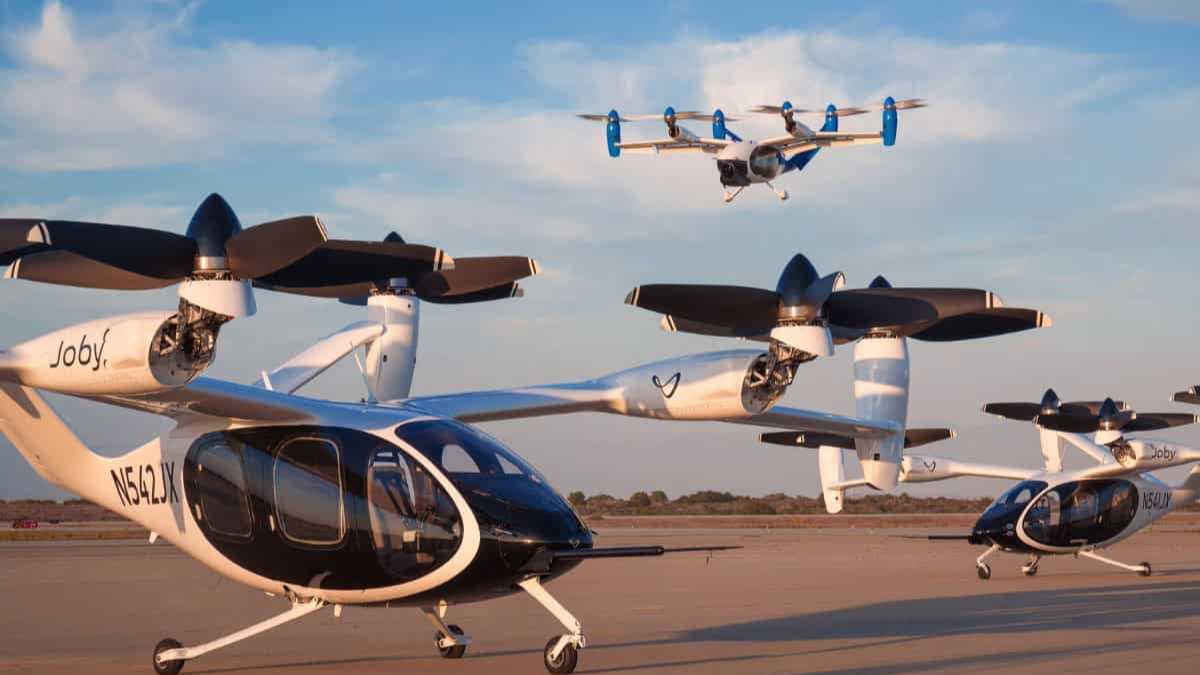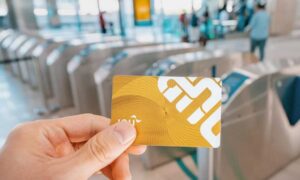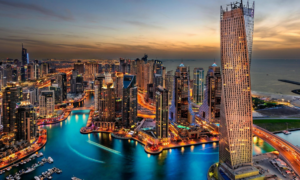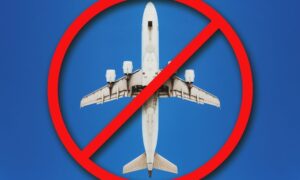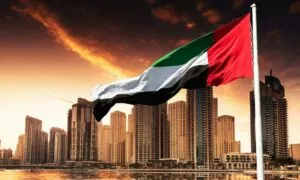In a historic leap toward futuristic travel, Dubai has commenced construction on its first aerial taxi vertiport located near Dubai International Airport, marking a new era for urban mobility. The project, announced by Sheikh Hamdan bin Mohammed bin Rashid Al Maktoum, Crown Prince of Dubai and Deputy Prime Minister of the UAE, aims to make Dubai the world’s first city with a fully functional aerial transport network. Designed to handle thousands of passengers annually, this innovative project supports Dubai’s vision of becoming a global leader in smart mobility and sustainable transport solutions.
Revolutionary Urban Mobility: A Vision for the Future
This groundbreaking vertiport, which will encompass 3,100 square meters, is expected to handle up to 42,000 landings and 170,000 passengers each year. Located strategically near Dubai International Airport, it will allow passengers to reach major destinations in Dubai with unmatched speed and convenience. Initial stations are planned for Downtown Dubai, Dubai Marina, and Palm Jumeirah, with service launches scheduled for 2026. The facility is part of a comprehensive network of four initial landing sites, setting the stage for a transportation revolution in the city.
Key Highlights of Dubai’s Aerial Taxi Vertiport Project
- Strategic Locations: Initial vertiports will be situated in Downtown Dubai, Dubai Marina, and Palm Jumeirah, offering accessible transit points for popular locations.
- Capacity and Efficiency: With a capacity of 42,000 landings and 170,000 passengers annually, the vertiport will cater to the high demand expected for urban air travel in Dubai.
- Launch Timeline: The first aerial taxi station will be operational by 2026, with the goal of reducing travel times significantly.
Driving Dubai’s Mobility Vision with Innovation and Sustainability
According to Sheikh Hamdan, Dubai’s commitment to innovation, safety, and sustainability plays a pivotal role in shaping the future of global mobility. The aerial taxi initiative demonstrates Dubai’s proactive approach to pioneering urban transport, blending advanced technologies with environmentally friendly designs to create an efficient and low-emission transport system. By establishing the first urban air taxi network, Dubai continues to lead the world in urban transit innovation, providing a model for other cities to follow.
Time-Saving Benefits of Aerial Taxi Service: Cutting Commute Times by Over 75%
One of the most appealing aspects of Dubai’s aerial taxi service is its ability to drastically reduce travel times. Currently, travel from Dubai International Airport to Palm Jumeirah during peak hours can take over 45 minutes. With the introduction of the aerial taxi, this travel time could be reduced to just 10-12 minutes, allowing for swift, comfortable, and stress-free transit across the city.
A Collaborative Effort: Partnerships for a Seamless Operation
Dubai’s aerial taxi project represents a significant collaboration between global leaders in aviation and infrastructure. Joby Aviation will manage the manufacturing, operations, and passenger movement for the aircraft, while Skyports will oversee the design, construction, and operational management of the vertiport infrastructure. The Roads and Transport Authority (RTA) will play a key role in regulating the system, ensuring seamless integration with Dubai’s existing transport network.
- Joby Aviation’s Role: Joby Aviation, a leader in electric vertical take-off and landing (eVTOL) aircraft, is responsible for the core aerial taxi operations, from manufacturing to passenger logistics.
- Skyports’ Contribution: Known for its expertise in urban air mobility infrastructure, Skyports will ensure the smooth construction and operation of the vertiport, creating a safe and efficient environment for aerial taxi services.
- RTA’s Oversight: The Roads and Transport Authority will manage the governance and regulatory aspects of the project, ensuring it integrates seamlessly with other modes of public transport across Dubai.
State-of-the-Art Aircraft: The Joby S4 Aerial Taxi
The Joby S4 aerial taxi is the primary aircraft model designated for Dubai’s aerial transport service. This cutting-edge eVTOL aircraft features vertical take-off and landing capabilities, allowing it to operate efficiently in urban settings with limited space. The Joby S4 stands out due to its zero-emission electric power, offering a greener alternative to conventional helicopters and significantly reducing noise pollution.
Key Features of the Joby S4
- Eco-Friendly Design: The Joby S4 operates entirely on electric power, producing zero emissions and aligning with Dubai’s sustainable transport goals.
- Impressive Speed and Range: With a flight range of up to 161 kilometers and a top speed of 321 kilometers per hour, the Joby S4 is built to navigate urban air corridors efficiently.
- Passenger Capacity: The aircraft accommodates four passengers along with a pilot, providing a balance of comfort, speed, and safety for urban air travelers.
- Reduced Noise Levels: Compared to traditional helicopters, the Joby S4 generates substantially less noise, enhancing the quality of life for city residents.
The Timeline for Dubai’s Aerial Taxi Service: What to Expect in the Coming Years
The aerial taxi project is set to advance in phases, with the initial vertiport near Dubai International Airport expected to be completed by 2026. By the first quarter of 2026, Dubai will be home to the world’s first aerial taxi stations, offering an innovative and efficient alternative to traditional modes of transport. As additional vertiports are constructed and operationalized, Dubai aims to expand its aerial taxi network across more locations, transforming how residents and visitors experience the city.
Projected Phases for Implementation
- Phase 1 (2023-2025): Construction of the first vertiport and preparation of initial infrastructure, primarily around Dubai International Airport.
- Phase 2 (2026): Launch of the aerial taxi service with four initial landing sites, marking the official start of Dubai’s urban aerial transport network.
- Phase 3 (Post-2026): Expansion of the vertiport network to include more locations, increasing the reach and accessibility of the service.
Economic and Environmental Impact: A Step Toward Sustainable Urban Mobility
Dubai’s aerial taxi initiative is more than just a transportation upgrade—it represents a commitment to sustainable urban mobility that balances economic growth with environmental responsibility. By opting for an all-electric air taxi service, Dubai aims to reduce carbon emissions, contributing to a cleaner urban environment. The project is expected to attract tourists, business travelers, and locals alike, boosting Dubai’s economy while setting a global benchmark for eco-friendly urban transit.
Environmental Benefits of the Aerial Taxi System
- Reduction in Carbon Emissions: Electric-powered aerial taxis offer a zero-emission mode of travel, in line with Dubai’s sustainability targets.
- Noise Reduction: The advanced design of the Joby S4 ensures minimal noise, enhancing the urban environment for Dubai’s residents.
- Resource Efficiency: By reducing road congestion and travel times, the aerial taxi service will contribute to more efficient use of urban space and resources.
Preparing for the Future: Dubai’s Vision for Integrated Urban Mobility
The aerial taxi project is part of Dubai’s broader vision to integrate multiple modes of transportation, creating a seamless and interconnected network that accommodates ground, air, and marine transport. By incorporating aerial taxis into its infrastructure, Dubai is setting a new standard in urban transit and positioning itself as a global leader in smart city innovation. The Roads and Transport Authority will play a key role in regulating and managing this new mode of transit, ensuring it complements existing services and enhances the city’s overall mobility framework.

